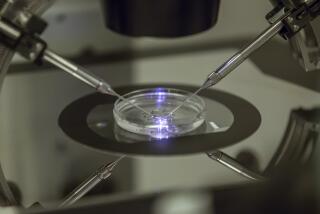Fertile Ground: : New techniques involving direct extraction of reproductive tissue from men allow some couples battling infertility to have children.
- Share via
Several years ago, researchers showed that a single sperm could be drawn into a hollow needle and injected directly into an egg, a procedure known as intracytoplasmic sperm injection. ICSI is now widely performed at infertility clinics nationwide.
More recent, infertility doctors have found ways to extract a small amount of immature sperm (sperm mature as they move through the male reproductive tract) directly from the testicle or epididymis during a brief outpatient surgery. A single sperm is isolated from this sample and then used in ICSI to establish a pregnancy.
Together, these advances in the treatment of infertility have shattered two long-held beliefs about human biology. One is that sperm must reach maturity through ejaculation to fertilize the egg. The other is that only the sperm can penetrate the egg to cause conception.
The latter procedure, known as testicular sperm extraction, is rapidly gaining acceptance as a way to treat infertile men who have had vasectomy reversals that have failed or who have congenital defects, such as the absence of a vas deferens, the duct that transports sperm from the testes.
“Male infertility is a major cause of all infertility, and it’s the area where we’ve been the poorest at,” said Dr. Geoffrey Sher, executive medical director of Pacific Fertility Center in San Francisco. The center also has clinics in Torrance, Glendale and Westlake Village.
About half of all infertility cases are due to male factors, and about one in eight of those are because of failed vasectomy reversal or congenital abnormalities. In such cases, experts say the new sperm extraction techniques could help thousands of couples who desire children.
“This treatment is really wonderful for [certain] men,” said Dr. Joel Batzofin of the Huntington Reproductive Center in Pasadena. “It’s a great addition to the whole field of assisted reproductive medicine.”
Although vasectomy is considered a permanent method of birth control, the procedure can often be reversed for men who later decide they want to father a child. The surgery, which costs about $5,000, is successful in reestablishing the duct in about 70% of cases.
According to Sher, however, fewer than half of these men will succeed in fathering a child.
The procedure sometimes fails because scar tissue forms to re-block the duct. Another problem is that after a vasectomy, sperm can leak out over time and trigger the body’s immune system to create antibodies to sperm. Anti-sperm antibodies can prevent fertilization.
“Sperm leakage results in about 80% of men having antibodies to his own sperm after 10 years” of having had the vasectomy, Sher says.
Thus, a man who had a vasectomy more than a decade ago and wishes to have a reversal might be better off skipping the reversal and trying testicular sperm extraction. Men can also be tested for the presence of sperm antibodies to help them decide which procedure is the best approach.
Batzofin advises couples to consider both partners’ roles. If the man has a vasectomy reversal and it works, he could impregnate his wife the natural way. If the couple opts for sperm extraction, she would have to undergo medical procedures as well, including surgery to remove her eggs and a procedure to transfer any resulting embryos to her uterus.
“The man’s partner goes through so much more [with sperm extraction] than if he has a vasectomy reversal,” said Batzofin, who prefers the technique of extracting sperm from the epididymis. “I think the decision should also depend on how many children they want. They might want to try vasectomy reversal if they want several children, but a sperm extraction if they just want one child.”
The sperm extraction techniques, whether through the testes or epididymis, are simple procedures.
“It takes 10 minutes, and the guy can go play golf afterward,” said Sher, who prefers the testicular sperm extraction technique. “This procedure eliminates the need for invasive surgery [the vasectomy reversal]. Why not leave a man with his contraceptive choice and still have a baby?”
The procedures are also a gift to men who are born without a vas or who have suffered injuries or diseases that block sperm ejaculation.
Zsolt Felenyi, 27, and his wife, Zsuzsanna, recently became the parents of twins as a result of a testicular sper been able to get sperm from just about everybody,” he said.
(BEGIN TEXT OF INFOBOX / INFOGRAPHIC)
New Hope for Infertile Men
A new treatment is giving hope to thousands of men who have been diagnosed as infertile because of failed vasectomy reversals or congenital defects.
1. A tiny amount of tissue is removed from the testical or epididymis. This is called testicular sperm extraction or percutaneous epididymal sperm aspiration, depending on where the tissue is taken from.
2. Sperm are isolated within this tissue sample.
3. A single sperm is selected, drawn into a hollow needle and injected directly into an egg. This step is called intracytoplasmic sperm injection (ICSI).
4. If the egg is fertilized, the embryo is transferred to the woman’s uterus.






